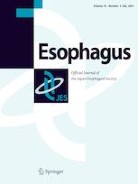業績報告 【accept】郷田憲一 先生 Esophagus誌
郷田憲一先生の論文が、Esophagus誌 (Journal Citation Reports Impact Factor 2019 = 3.130)にacceptされました。
Esophagus. 2021 May 30. doi: 10.1007/s10388-021-00841-1. Online ahead of print.
Diagnostic utility of a novel magnifying endoscopic classification system for superficial Barrett’s esophagus-related neoplasms: a nationwide multicenter study
Kenichi Goda, Manabu Takeuchi, Ryu Ishihara, Junko Fujisaki, Akiko Takahashi, Yasuhiro Takaki, Dai Hirasawa, Kumiko Momma, Yuji Amano, Kazuyoshi Yagi, Hiroto Furuhashi, Satoru Hashimoto, Takashi Kanesaka, Tomoki Shimizu, Yoichiro Ono, Taku Yamagata, Junko Fujiwara, Takane Azumi, Gen Watanabe, Yasuo Ohkura, Masako Nishikawa, Tsuneo Oyama
Affiliations expand
PMID: 34052965 DOI: 10.1007/s10388-021-00841-1
Abstract
Background: Currently, no classification system using magnification endoscopy for the diagnosis of superficial Barrett’s esophagus (BE)-related neoplasia has been widely accepted. This nationwide multicenter study aimed to validate the diagnostic accuracy and reproducibility of the magnification endoscopy classification system, including the diagnostic flowchart developed by the Japan Esophageal Society-Barrett’s esophagus working group (JES-BE) for superficial Barrett’s esophagus-related neoplasms.
Methods: The JES-BE acquired high-definition magnification narrow-band imaging (HM-NBI) images of non-dysplastic and dysplastic BE from 10 domestic institutions. A total of 186 high-quality HM-NBI images were selected. Thirty images were used for the training phase and 156 for the validation (test) phase. We invited five non-experts and five expert reviewers. In the training phase, the reviewers discussed how to correctly predict the histology based on the JES-BE criteria. In the validation phase, they evaluated whether the criteria accurately predicted the histology results according to the diagnostic flowchart. The validation phase was performed immediately after the training phase and at 6 weeks thereafter.
Results: The sensitivity and specificity for all reviewers were 87% and 97%, respectively. Overall accuracy, positive predictive value, and negative predictive value were 91%, 98%, and 83%, respectively. The overall strength of inter-observer and intra-observer agreements for dysplastic histology prediction was κ = 0.77 and κ = 0.83, respectively. No significant difference in diagnostic accuracy and reproducibility between experts and non-experts was found.
Conclusion: The JES-BE classification system, including the diagnostic flowchart for predicting dysplastic BE, is acceptable and reliable, regardless of the clinician’s experience level.
Keywords: Barrett’s esophagus-related neoplasia; Barrett’s esophagus; Classification system; Esophageal adenocarcinoma; Magnification endoscopy.
https://pubmed.ncbi.nlm.nih.gov/34052965/

